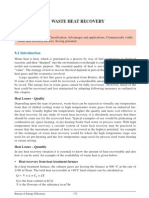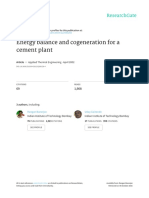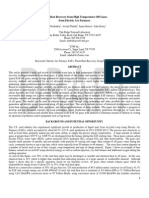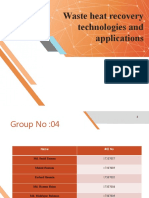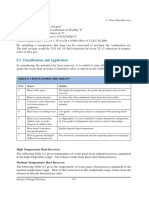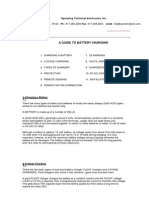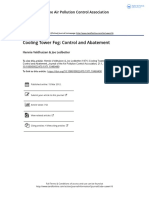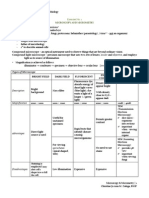V3i5 Ijertv3is051014 PDF
V3i5 Ijertv3is051014 PDF
Uploaded by
Raja ShannmugamCopyright:
Available Formats
V3i5 Ijertv3is051014 PDF
V3i5 Ijertv3is051014 PDF
Uploaded by
Raja ShannmugamOriginal Title
Copyright
Available Formats
Share this document
Did you find this document useful?
Is this content inappropriate?
Copyright:
Available Formats
V3i5 Ijertv3is051014 PDF
V3i5 Ijertv3is051014 PDF
Uploaded by
Raja ShannmugamCopyright:
Available Formats
International Journal of Engineering Research & Technology (IJERT)
ISSN: 2278-0181
Vol. 3 Issue 5, May - 2014
Waste Heat Recovery in Cement plant
S. Nivethidha Priyadarshini1, D. B. Sivakumar2
1
Master of Technology Student, ANNA UNIVERSITY Trichy, INDIA
Assistant Professor, Department of Mechanical Engineering, ANNA UNIVERSITY Trichy, INDIA
Keywords-E n e r g y a u d i t ; H e a t l o s s ;
Preheater;
Cooler; Heat recovery; Clinker; Steam cycle ;
I. INTRODUCTION
Waste heat recovery from the hot gases in the
system can be considered as a potential option to improve
energy efficiency in industrial processes. The Waste heat
is heat, which is generated in a process by way of fuel
combustion or chemical reaction, and then dumped into
the environment even though it could still be reused for
some useful and economic purpose. The essential quality
of heat is not the amount but rather its temperature of the
waste heat gases and the economics involved. Large
quantity of hot flue gases is generated from Boilers, Kilns,
Ovens and Furnaces. If some of this waste heat could be
recovered, a considerable amount of primary fuel could be
saved. The energy lost in waste gases cannot be fully
recovered. Waste heat Recovery means allowing the waste
heat to leave the process, but converting into electricity
before it is discharged at lower temperature level to the
environment. Therefore, after the efficiency of a cement
plant has been driven to the economic optimum, the
remaining waste heat is converted into electricity. Waste
heat recovery system: The waste heat available in the
exhaust gases can be recovered and used for drying the
moisture in the raw material and coal or for generating
power. In addition to the plan of reducing of energy
consumption in cement production process, the recovery
waste heats can be achieved in order to produce the
electrical energy by utilization cogeneration power plant.
This means no additional fuel consumption and thus,
IJERTV3IS051014
reducing the high cost of electrical energy and the
emissions of greenhouse gases. In cement plant the exit
gases from Rotary kilns, pre-heater and Calciners are used
to heat the incoming feed material and gases are cooler
around 300 to 350 C in 4 stage pre-heater and then
exhausted to the atmosphere.
II. SYSTEM DESCRIPTION AND DATA SOURCE
The cement industry has an important role in
the economy based on its production. During the
production of Cement natural resources are consumed
in large amounts. The most important raw materials
for the manufacture of cement are limestone (CaCO3)
and clay or calcareous clay in which both Components
are already naturally mixed. The components are
milled and dried with flue gases from the clinker kiln.
Depending on the type of cement to be produced, the
following product may be added to the dried limestone
subsequently: Pyrite ash, fly ash from coal fired power
plants, sandy clay and filter ash from the electrostatic
precipitator present. The mixture obtained is ground
and subsequently fired in a rotary furnace to cement
clinkers. For heating, various fuels and other
combustible materials, for example coal dust,
petroleum coke, etc., are used. Depending on the type
of preheating of the material, it is differentiated
between grate and cyclone preheating, whereby the
starting materials are preheated to 700 to 800C. The
raw materials pass through the rotary furnace towards
the flame. In the hottest zone, the material being fired
reaches temperatures of around 1450C.The cement
plant considered is Dalmia CementUnit 2,
Trichirapalli, India. A schematic of the plant (Fig. 1)
shows
the flow of various streams and the
components of the plant. The plant runs on dry process
with a four stage suspension preheater and an inline
Calciners. The production capacity is 3018 tonne per
day. It is the pyroprocessing unit that includes the
preheater, the Calciners, the kiln and the clinker
cooler. The streams into the system are the raw
material, the air into the cooler and the coal fired into
the kiln and the Calciners. The streams leaving the
system are clinker out from the cooler, the exhaust
gases from the preheater and the hot air out from the
cooler.
IJE
RT
Abstract Cement production has been one of the most
energy intensive industries in the world. In order to produce
clinker, rotary kilns are widely used in cement plants. To
achieve effective and efficient energy management scheme,
thermal energy audit analysis was employed in the Dalmia
cement plant. Reduction of the production cost and
consumption cost is very much important because of
that waste heat recovery is implemented in the cement
industry. The waste heat recovery reduces the Green house
gas emissions and enhances the overall system performance.
The aim of this work is to determine the Power
Generation by utilizing the waste exit gases from the
Pre-heater, Grate cooler. By using the various Energy
Auditing
instrument the exhaust gas temperature, Dust
concentration , Surface temperature, Velocity were
identified. A detailed analysis of Grate cooler, Preheater
are done and the possible approaches of heat recovery
from some major heat loss sources.
www.ijert.org
814
International Journal of Engineering Research & Technology (IJERT)
ISSN: 2278-0181
Vol. 3 Issue 5, May - 2014
capacity would declare an efficiency of 55% based on dry
process methodology. The overall efficiency of the system
can be improved by recover some of the heat losses.
III. MASSBALANCE AND ENERGY BALANCE
A. Mass balance
The average compositions for dried coal
are shown in Fig. 1 Based on the coal composition, the
net heat value has been found to be 30,600kJ/kg-coal.
The stream data obtained from the plant is used to
perform a mass balance over the system. It is usually
more convenient to define mass/energy data per kg
clinker produced per unit time. The mass balance of
the kiln system is summarized in Fig. 3. All gas
streams are assumed to be ideal gases at the given
temperatures.
IJE
RT
IV.WASTEHEAT
RECOVERY
AND
POWER
GENERATION
There are opportunities that exist within the
plant to capture the heat that would otherwise be wasted to
the environment and utilize this heat to generate
electricity. The most accessible and, in turn, the most cost
effective waste heat losses available are the clinker cooler
discharge and the kiln exhaust gas. The exhaust gas from
the Preheater is, on average , 361 C, and the temperature
of the air discharged from the cooler stack is 268C.The
B. Energy balance
hot gases from the preheater and cooler are passed through
the waste heat recovery boiler. Water is circulated through
In order to analyze the kiln system
the WHRB. Latent heat from the hot gas is transferred to
thermodynamically, the following assumptions are
the water and it is converted to steam. The steam is
made
expanded in the turbine and then it is condensed and the
1. Steady state working conditions.
condensed water is passed through the WHRG and the
2. The change in the ambient temperature is
process repeats.The electricity generated would offset a
neglected.
portion of the purchased electricity, thereby reducing the
electrical demand.
3. Cold air leakage into the system is negligible.
Power generation
4. Raw material and coal compositions do not
Generally the waste heat recovery efficiency is 22.7%.The
change.
total heat available for power generation is 9.92Mcal/hr.
5. Averaged kiln surface temperatures do not
Gross power generation
change.
= Total heat available for power generation*WHR
efficiency*1000
Based on the collected data, an energy balance is applied
= 9.92 * 0.227 * 1000/860
to the kiln system. The Datum Temperature is taken as
Assuming 8000h usage, we find
20C. Based on the collected data, an energy balance is
Energy saved = power generated * Hour usage
applied to the kiln system. The Datum Temperature is
= 2620 * 8000
taken as 20C. The pertinent equations used in evaluating
= 20960000 Kwh/year
the different Heat transfer components of the systems
energy balance are shown inTable1.The Relevant data and
Cost savings = Unit price of electricity * Energy saved
constants are obtained from on site measurements, plant
= 3.75 * 20960000
records Peray [8].The result presented in Table 1, shows
= 78,600,000 Rupees/year
that fuel combustion generate 97.3% (780 kJ/kg clinker)
of the total heat input to the unit. The sensible heats with
the raw materials, fuel and air entering the coolers heat
content are very small. The total sensible heats with
streams are about 0.2% of the total heat input to the unit.
Therefore, total heat input of 801.9 kJ/kgclinker is
required to maintain Clinkerization reactions temperatures
for the clinker formation. The total heat input is generated
from combustion heat and total sensible heat with the total
heat input to the unit. The total heat input is generated
from combustion heat and total sensible heat with the
material streams. During clinker formation, 413.2
kJ/kgclinker of heat is released, about 51.5% of the total
heat input. This percentage gives a measure of the thermal
efficiency of the kiln systems. The overall efficiency can
be improved by recovering some of the heat losses. The
recovered energy can then be used for several purposes,
such as electricity generation. There are few major heat
losses that would be considered for recovery. Theseare
heat losses by Preheater exhaust gas (24.4%), from cooler
Fig2. Mass balance of the system
stack (12.8%) and Radiation and convection losses
(6.1%).The overall system efficiency can be defined by
Q5/Qtotal input = 413/801.9= 0.515 or 51.5% which can be
regarded as low. Some kiln system operating at full
IJERTV3IS051014
www.ijert.org
815
International Journal of Engineering Research & Technology (IJERT)
ISSN: 2278-0181
Vol. 3 Issue 5, May - 2014
An additional cost will be required for maintenance of the power
generation unit. For the whole system shown in fig 3, based on
our calculations, we were able to determine a budget estimation
of 136400000 rupees/year. We can make a rough estimate for a
simple payback period.
Simple payback period = (Implementation cost)/(Cost savings)
= 136400000/78600000
= 1.73 years
Operational approach for thermal energy saving opportunities
Potential opportunities for improving energy efficiency of the
pyroprocessing unit could be achieved from the following
operational approach
- Upgrading existing equipments in the pyroprocessing unit
Fig 1.Composition of coal
Table 1 Heat balance of the kiln system
Heat Input
Equation used
kiln Feed
Q1=mCp(T2-T1)
Cooling air
Q2=mCp(T2-T1)
Coal
dust
sensible heat
From fuel(By
difference)
Total Heat
Q3=mCp(T2-T1)
Q4
Data
m=0.2155kg/kg clinker,
Cp=215kJ/kgC,T1=20C,T2=60C
m=1.816kg/kg clinker,
Cp=0.31J/kgC,T1=20C,T2=29C
m=1.816kg/kg clinker,
Cp=0.31J/kgC,T1=68C,T2=20C
-
IJE
RT
Description
Results(kcal/kgclinker)
15.1(1.9%)
5.1(0.6)
1.70(0.2%)
780(97.3%)
801.9(100%)
Heat Output
Description
Heat
of
formation
Equation used
Q5=
(4.11*Al2O3)+
(6.48*Mgo)
+(7.646*CaO)+(5.1165*SiO2)+(0.59*Fe2O3)
Kiln
feed
moisture
temperature
Q6=kilnfeed
rate*Moisture
in
kilnfeed*540/clinker
production
Q7=Fuel rate*moisture
in
coaldust*540/clinker
production
Q8 = mCp(T2 -T1)
Kilnfeedrate = 215TPH Moisture in kiln feed =
0.5%
Clinkerproduction =125.73TPH
4.6(0.6%)
Fuel rate = 15.3
Moisture in coal dust = 3.310%
Clinkerproduction =125.73TPH
2.2(0.3%)
m=1.621 kJ/kg clinker,
Cp=0.354kJ/kgC,T1=20C,T2=361C
195.7(24.4%)
Q9= mCp(T2 -T1)
m=1.621 kJ/kg clinker,
Cp=0.100kJ/kgC,T1=20C,T2=361C
12.8(1.6%)
Q6= mCp(T2 -T1)
m=1.307 kJ/kg clinker,
Cp=0.317kJ/kgC,T1=20C,T2=268C
m=1kg/kg clinker,
Cp=0.189kJ/kgC, T1=20C,T2=135C
102.78(12.8%)
Coal
dust
moisture
temperature
Heat through
Preheater
exhaust gas
Heat through
dust entrained
in
Preheater
exhaust gas
Heat through
cooling vent air
Heat through
Clinker
Radiation
and convection losses
(cooler,
kiln,
preheater,
Duct)
Total Heat loss
IJERTV3IS051014
Q7= mCp(T2 -T1)
Data
Al2O3 = 5.630
Mgo = 0.850
CaO= 64.870
SiO2 = 21.160
Fe2O3 = 5.340
Results(kcal/kgclinker)
413.2(51.5%)
21.7(2.7%)
48.8(6.1%)
___
__
__
__
www.ijert.org
801.9(100%)
816
International Journal of Engineering Research & Technology (IJERT)
ISSN: 2278-0181
Vol. 3 Issue 5, May - 2014
Table 2 Heat utilization
Description
Preheater heat
available from
exhaust gas
Cooler Heat
Available
from
Exit
Gases
Preheater
Heat
available for Raw mill
and Coal mill at
WHRS Outlet
Equation used
Data
m=0.34kg/kg clinker,
Cp=204 kJ/kgC, T= 380 C
Results(Mcal/hr)
26.36
Q1= mCp(T2 -T1)
18.97
Q2= mCp(T2 -T1)
m=0.34kg/kg clinker,
Cp=204 kJ/kgC, T= 380 C
Q3= mCp(T2 -T1)
25.04
m=0.34kg/kg clinker,
Cp=204 kJ/kgC, T= 361 C
Q4= mCp(T2 -T1)
m=0.354 kJ/kg clinker,
Cp=204kJ/kgC,T1=361C,T2=380C
1.32
Total
heat
from
Cooler mid tap for
boiler
Q5= mCp(T2 -T1)
m=99kg/kg clinker,
Cp=0.317 kJ/kgC, T= 400 C
12.29
Useful cooler heat
available at 120 c
exit temp for cooler
mid tap boiler
Unused heat
vented to atm
at 120Cfrom
cooler midtap
boiler
Total heat available
for power generation
Q6= mCp(T2 -T1)
m=99 kJ/kg clinker,
Cp=0.31kJ/kgC,T1=120C,T2=400C
8.59
Q7= mCp(T2 -T1)
m=99 kJ/kg clinker,
Cp=0.31kJ/kgC,T1=120C,T2=400C
3.69
Q4+Q6
Q4=1.32
Q6=8.60
9.92
IJE
RT
Preheater
Heat
available for boiler
Fig 3.Waste heat recovery power plant
- Combustion system improvement
- Adding multistage preheater with Pre-Calciners
- Adopting new pyroprocessing technologies
- Utilizing alternative fuel such as harvesting energy from
Biomass and waste fuel for kiln firing
IJERTV3IS051014
www.ijert.org
- Replacing high carbon fuel with low carbon fuel (i.e.
switching
From coal to natural gas)
- Applying a low clinker to final cement mixture ratio (i.e.
increasing the ratio of cement additives that do not require
Pyroprocessing)
817
International Journal of Engineering Research & Technology (IJERT)
ISSN: 2278-0181
Vol. 3 Issue 5, May - 2014
V.CONCLUSIONS
A detailed energy audit analysis, which can be
directly applied to any dry kiln system, has been made for
a specific key cement Plant. According to the result
obtained the overall system efficiency is 51.53%.The
major heat loss sources have been determined as kiln
exhaust (19.15%), cooler exhaust (12.8%) Heat through
Preheater gas (24.4%) and combined radiative and
convective heat transfer from kiln surfaces
(6.1%).The
Preheater Exhaust gas temperature is (361C) and Cooler
Exhaust gas temperature (268C) which are used in waste
heat boiler for power generation. A waste heat recovery
steam generation system was selected showing the energy
saving potential of 2.62 MW from the waste heat streams
with simple pay back of 30 months.
VII.REFERENCES
Vedat Ari, Energetic and exergetic assessments of a cement rotary
kiln system, Scientific Research and Essays Vol. 6(6), pp. 14281438, 18 March, 2011.
[2] G. Kabir, A.I.Abubakar, U.A. El-Nafaty, Energy audit and
conservation opportunities for pyroprocessing unit of a typical dry
process cement plant, Chemical Engineering Programme, Abubakar
Tafawa Balewa University, Energy 35 (2010) 1237-1245.
[3] Shaleen Khurana, Rangan Banergee, Uday Gaitonde, Energy
balance and cogeneration for a cement plant. Applied Thermal
Engineering 22 (2002) 485494.
[4] N.A.Madlool, R.Saidura, M.S.Hossain, N.A.Rahim, A critical
review on energy use and savings in the cement industries,
Renewable and Sustainable Energy Reviews 15 (2011) 20422060.
[5] M.G.Rasul, W.Widianto, B.Mohanty, Assessment of the thermal
performance and energy conservation opportunities of a cement
industry in Indonesia, Applied Thermal Engineering 25 (2005)
29502965.
[6] TahsinEngin, Vedat Ari, Energy auditing and recovery for dry type
cement rotary kiln systemsA case study, Energy Conversion and
Management 46 (2005) 551562.
[7] Aly Moustafa Radwan, Different Possible Ways for Saving Energy
in the cement production, Advances in Applied Science Research,
2012, 3 (2):1162-1174.
[8] Peray KE. Cement manufacturers handbook. New York, NY:
Chemical Publishing Co., Inc.; 1979.
[9] N.A. Madlool, R. Saidur, M.S. Hossain, N.A. Rahim, A critical
review on energy use and savings in the cement industries,
Renewable and Sustainable Energy Reviews 15 (2011) 20422060.
[10] A. Ramesh, Leo. A. J, G. Madhu, Energy audit of thermal utilities
in a cement plant, International Journal of Mechanical Engineering
(IJME) Vol. 2, Issue 2, May 2013, 11-22.
[11] S. Karellas, A.D. Leontaritis, G. Panousis, E. Bellos, E.
Kakaras, Energetic and exergetic analysis of waste heat
recovery systems in the Cement industry, Energy 58 (2013)
147-156.
IJE
RT
[1]
IJERTV3IS051014
www.ijert.org
818
You might also like
- BYHX SystemDocument13 pagesBYHX SystemErkan Kabakçı100% (6)
- Roles and Responsibilities of A Project Manager PDFDocument5 pagesRoles and Responsibilities of A Project Manager PDFRaja Shannmugam83% (6)
- Code 014 8 SPFLI ExampleDocument4 pagesCode 014 8 SPFLI ExampleMrYenThanhNo ratings yet
- CFD Modeling of Waste Heat Recovery On The Rotary Kiln System in The Cement IndustryDocument17 pagesCFD Modeling of Waste Heat Recovery On The Rotary Kiln System in The Cement Industryghada ghoudiNo ratings yet
- Energy Auditing and Recovery For Dry Type Cement Rotary Kiln Systems A Case StudyDocument12 pagesEnergy Auditing and Recovery For Dry Type Cement Rotary Kiln Systems A Case Study1977julNo ratings yet
- Sinter Coolers: International Journal For Research in Applied Science & Engineering Technology (IJRASET)Document3 pagesSinter Coolers: International Journal For Research in Applied Science & Engineering Technology (IJRASET)iaetsdiaetsdNo ratings yet
- The Most Efficient Waste Heat Recovery Device: A Gamma Type Stirling EngineDocument7 pagesThe Most Efficient Waste Heat Recovery Device: A Gamma Type Stirling EngineSutarmoNo ratings yet
- 68 Ijaet Vol III Issue I 2012Document6 pages68 Ijaet Vol III Issue I 2012Ssheshan PugazhendhiNo ratings yet
- WASTE HEAT RECOVERY (HRSG) PerformanceDocument17 pagesWASTE HEAT RECOVERY (HRSG) PerformanceEjaz AhmedNo ratings yet
- ECONOMIZER DESIGN FOR 2013 - Sayı 3 - 4 - Selçuk Selimli PDFDocument6 pagesECONOMIZER DESIGN FOR 2013 - Sayı 3 - 4 - Selçuk Selimli PDFNITINNo ratings yet
- Energy Balance and Cogeneration For A Cement PlantDocument11 pagesEnergy Balance and Cogeneration For A Cement PlantHeron SoaresNo ratings yet
- Cog en Era Ti OnDocument12 pagesCog en Era Ti OnMayank DubeyNo ratings yet
- Literature Review On Cement Industry WHRDocument24 pagesLiterature Review On Cement Industry WHRnihal attarNo ratings yet
- 2.8 Waste Heat Recovery-LibreDocument18 pages2.8 Waste Heat Recovery-Libredivyank3dNo ratings yet
- Energy ManagementDocument20 pagesEnergy Managementhasan_jafri_2No ratings yet
- Cement Plant-Heat Balance PDFDocument14 pagesCement Plant-Heat Balance PDFtsrinivasan5083100% (2)
- CogenerationDocument53 pagesCogenerationSri Ch.V.Krishna Reddy Assistant Professor (Sr,)No ratings yet
- Mallela 2018Document15 pagesMallela 2018Jorge Neyra MacedoNo ratings yet
- Analysis of Heat Loss in Kiln in Cement Industry-A Review: April 2016Document5 pagesAnalysis of Heat Loss in Kiln in Cement Industry-A Review: April 2016akbar davoodiNo ratings yet
- Cement Plant Thermal EnergyDocument7 pagesCement Plant Thermal Energytsrinivasan5083No ratings yet
- Unit 3Document22 pagesUnit 3Pavithran RajaNo ratings yet
- Recoverable Quantity of Waste Heat From Kiln and Preheater Systems and Economic Analysis (Case of Messebo Cement Factory)Document13 pagesRecoverable Quantity of Waste Heat From Kiln and Preheater Systems and Economic Analysis (Case of Messebo Cement Factory)abdulfetahNo ratings yet
- Waste Heat Recovery Power Plant - Cement PlantDocument7 pagesWaste Heat Recovery Power Plant - Cement PlantknsaravanaNo ratings yet
- 3194 PDF PDFDocument7 pages3194 PDF PDFdillipsh123No ratings yet
- A Review of Automobile Waste Heat Recovery System: Prof. Murtaza Dholkawala, Mr. Ahire Durgesh VijayDocument7 pagesA Review of Automobile Waste Heat Recovery System: Prof. Murtaza Dholkawala, Mr. Ahire Durgesh VijayJijo GeorgeNo ratings yet
- Study of Vapour Absorption System Using Waste Heat-F0283439Document6 pagesStudy of Vapour Absorption System Using Waste Heat-F0283439Anonymous NGXdt2BxNo ratings yet
- Cement Plants Cogeneration SD2002Document10 pagesCement Plants Cogeneration SD2002Leonidas VeraNo ratings yet
- Ecm Unit IIIDocument19 pagesEcm Unit IIIKrishnaNo ratings yet
- Waste Heat Recovery Steam Generator in Sponge Iron PlantDocument6 pagesWaste Heat Recovery Steam Generator in Sponge Iron PlantthesijNo ratings yet
- Evaporative CoolerDocument6 pagesEvaporative Coolersujiv_sujiv1278No ratings yet
- Waste Heat To Power Systems PDFDocument9 pagesWaste Heat To Power Systems PDFWilson FigueiraNo ratings yet
- Unit 4 NotesDocument15 pagesUnit 4 Notesरितेश हरोडेNo ratings yet
- Ormat Technologies Inc. - Ormat Energy Converters Proven Power From Cement Plant Waste Heat - 2013-05-09Document7 pagesOrmat Technologies Inc. - Ormat Energy Converters Proven Power From Cement Plant Waste Heat - 2013-05-09Kiran VeerubhotlaNo ratings yet
- Rohde2020erf PaperID 1174Document8 pagesRohde2020erf PaperID 1174daongocvu792002No ratings yet
- IJME Energyaudit A.RAMESHDocument13 pagesIJME Energyaudit A.RAMESHmanohar1005No ratings yet
- AISTech 2014 Article WHR From HT Gases From EAF 01042014Document11 pagesAISTech 2014 Article WHR From HT Gases From EAF 01042014sunatrutgersNo ratings yet
- Fuzzy Logic Controlled CHP Plant For Biomass Fuels Based On A Highly Efficient Orc Process"Document0 pagesFuzzy Logic Controlled CHP Plant For Biomass Fuels Based On A Highly Efficient Orc Process"TecsloNo ratings yet
- Organic Rankine Cycle Power PlantDocument6 pagesOrganic Rankine Cycle Power PlantPower PowerNo ratings yet
- EconomizerDocument7 pagesEconomizernsralmasiNo ratings yet
- ICMEAS 2017 Paper 86Document5 pagesICMEAS 2017 Paper 86adithyankv71No ratings yet
- Thermal Efficiency and Heat Balance of Reheating Furnace of Rolling MillsDocument15 pagesThermal Efficiency and Heat Balance of Reheating Furnace of Rolling MillsGidNo ratings yet
- Basic Calculations For A Power PlantDocument9 pagesBasic Calculations For A Power PlantMehmood Ahmad67% (6)
- Natural Gas EquipmentDocument26 pagesNatural Gas Equipmenthanisshi100% (1)
- 139 FPDocument7 pages139 FPKenny RuizNo ratings yet
- 2 China PDFDocument4 pages2 China PDFSiddharth ModiNo ratings yet
- TRIGENERATIONDocument21 pagesTRIGENERATIONShreyas Saumitra100% (1)
- 1 s2.0 S2451904918304050 MainDocument9 pages1 s2.0 S2451904918304050 MainJonathan TupizaNo ratings yet
- Co Generation Unit 4Document52 pagesCo Generation Unit 4Johnson Johnson100% (2)
- 10 1016@j Applthermaleng 2013 02 027Document11 pages10 1016@j Applthermaleng 2013 02 027pesek.llukasNo ratings yet
- Experiment No.:-3 TITLE: Study of Co-Generation Power Plant AIM: Study of Co-Generation Power Plant TheoryDocument10 pagesExperiment No.:-3 TITLE: Study of Co-Generation Power Plant AIM: Study of Co-Generation Power Plant Theory9527530909100% (1)
- Performance Analysis of A Thermal Power PlantDocument6 pagesPerformance Analysis of A Thermal Power Plantabhishekrathi09No ratings yet
- Waste Heat Recovery Technologies and Applications: ART-203 Group No:04Document17 pagesWaste Heat Recovery Technologies and Applications: ART-203 Group No:04Sazid ZamanNo ratings yet
- Classification and ApplicationDocument1 pageClassification and ApplicationKashyap DubeyNo ratings yet
- Industrial Waste Heat Recovery: Alfred PiggottDocument9 pagesIndustrial Waste Heat Recovery: Alfred PiggottNandha KumarNo ratings yet
- Thermodynamic analysis of geothermal heat pumps for civil air-conditioningFrom EverandThermodynamic analysis of geothermal heat pumps for civil air-conditioningRating: 5 out of 5 stars5/5 (2)
- Clean Ironmaking and Steelmaking Processes: Efficient Technologies for Greenhouse Emissions AbatementFrom EverandClean Ironmaking and Steelmaking Processes: Efficient Technologies for Greenhouse Emissions AbatementNo ratings yet
- Geothermal Energy: From Theoretical Models to Exploration and DevelopmentFrom EverandGeothermal Energy: From Theoretical Models to Exploration and DevelopmentNo ratings yet
- Sustainable Energy Conversion for Electricity and Coproducts: Principles, Technologies, and EquipmentFrom EverandSustainable Energy Conversion for Electricity and Coproducts: Principles, Technologies, and EquipmentNo ratings yet
- Mechanics of the Household: A Course of Study Devoted to Domestic Machinery and Household Mechanical AppliancesFrom EverandMechanics of the Household: A Course of Study Devoted to Domestic Machinery and Household Mechanical AppliancesNo ratings yet
- Encyclopaedia Britannica, 11th Edition, Volume 8, Slice 3 "Destructors" to "Diameter"From EverandEncyclopaedia Britannica, 11th Edition, Volume 8, Slice 3 "Destructors" to "Diameter"No ratings yet
- A Polygeneration Process Concept for Hybrid Solar and Biomass Power Plant: Simulation, Modelling, and OptimizationFrom EverandA Polygeneration Process Concept for Hybrid Solar and Biomass Power Plant: Simulation, Modelling, and OptimizationNo ratings yet
- LOGO! 0BA8 Reserved VM AddressesDocument3 pagesLOGO! 0BA8 Reserved VM AddressesRaja Shannmugam100% (1)
- 7SJ62-64 Manual AA V046401 UsDocument715 pages7SJ62-64 Manual AA V046401 UsstunnchuckNo ratings yet
- Com Profibus 7sj6x 6md63 UsDocument90 pagesCom Profibus 7sj6x 6md63 UshelveciolopesNo ratings yet
- Hmi MP 277 Operating Instructions en-US en-US PDFDocument214 pagesHmi MP 277 Operating Instructions en-US en-US PDFRaja ShannmugamNo ratings yet
- 411PROFIBUSENGDocument74 pages411PROFIBUSENGRaja Shannmugam0% (1)
- Lafarge Cement Optimization SolutionDocument2 pagesLafarge Cement Optimization SolutionRaja Shannmugam100% (1)
- A Guide To Battery ChargingDocument7 pagesA Guide To Battery Chargingsenkum812002No ratings yet
- Installation Troubleshooting Capacitors APFCSystemDocument23 pagesInstallation Troubleshooting Capacitors APFCSystemAshish ParasharNo ratings yet
- VFDs Understanding TopologiesDocument9 pagesVFDs Understanding TopologiesRaja ShannmugamNo ratings yet
- 6RA24 EnglischDocument496 pages6RA24 EnglischRaja ShannmugamNo ratings yet
- Basic Elect (1) .Mod.E-09 (CABLES) PDFDocument17 pagesBasic Elect (1) .Mod.E-09 (CABLES) PDFsamsungloverNo ratings yet
- MV Capacitor SizingDocument3 pagesMV Capacitor SizingRaja ShannmugamNo ratings yet
- Direct RetainersDocument8 pagesDirect RetainersKh JaNo ratings yet
- NCERT Science Lab Manual X Expt 48 PDFDocument5 pagesNCERT Science Lab Manual X Expt 48 PDFAlpha KingNo ratings yet
- Cadoff, I. B., Miller, E., Egli, P. H., & Balise, P. L. (1961) - Thermoelectric Materials and Devices and Thermoelectricity. Physics Today, 14 (5), 52-52Document2 pagesCadoff, I. B., Miller, E., Egli, P. H., & Balise, P. L. (1961) - Thermoelectric Materials and Devices and Thermoelectricity. Physics Today, 14 (5), 52-52Didin MuhidinNo ratings yet
- BCM SyllabusDocument3 pagesBCM Syllabussathish kumarNo ratings yet
- Cooling Tower Fog Control and AbatementDocument5 pagesCooling Tower Fog Control and AbatementoksaNo ratings yet
- 35 MRJN - Color Code Chart - Rev. 02Document1 page35 MRJN - Color Code Chart - Rev. 02احمد حسنNo ratings yet
- Scania Sops RedaktorDocument7 pagesScania Sops Redaktorscania100% (3)
- Perhitungan Box GirderDocument37 pagesPerhitungan Box GirderBambang Wahyu Widayat100% (1)
- University of Cambridge International Examinations General Certificate of Education Ordinary LevelDocument16 pagesUniversity of Cambridge International Examinations General Certificate of Education Ordinary Levelmstudy123456No ratings yet
- Potomac Valley Swimming: Meet Manager For Windows HandbookDocument18 pagesPotomac Valley Swimming: Meet Manager For Windows HandbooktrackprodNo ratings yet
- Bizhub 750 600 Service Manual - Main BodyDocument134 pagesBizhub 750 600 Service Manual - Main BodySMART REFILL100% (6)
- Computerized System of Graduate Students of NPCMSTDocument36 pagesComputerized System of Graduate Students of NPCMSTromeofatima100% (1)
- CH 3 Deisgn Formulae For Shear, Deflection and BondDocument29 pagesCH 3 Deisgn Formulae For Shear, Deflection and Bond秦瑋駿No ratings yet
- Sysmex Corporation Application Form IITB 2Document4 pagesSysmex Corporation Application Form IITB 2abhishek65cNo ratings yet
- 2017 BG CatalogueDocument200 pages2017 BG Catalogueazeemahmedkhan021No ratings yet
- 5th IJSO-Test Solution PDFDocument7 pages5th IJSO-Test Solution PDFВук РадовићNo ratings yet
- Penstock Lightduty WeirDocument5 pagesPenstock Lightduty WeirMohamed RamadanNo ratings yet
- Service ManualDocument262 pagesService ManualAntonio Cavalcante100% (2)
- Course Notes PDFDocument96 pagesCourse Notes PDFshaliq28No ratings yet
- Dieci Zeus 33.11 35.10 & 40.7 Spec SheetDocument4 pagesDieci Zeus 33.11 35.10 & 40.7 Spec SheetNash ServiceNo ratings yet
- Ponnam Sriram 21401064337 Ponnam Chandraiah: Tsecet - 2020 Telangana State Council of Higher EducationDocument2 pagesPonnam Sriram 21401064337 Ponnam Chandraiah: Tsecet - 2020 Telangana State Council of Higher EducationHappy HourNo ratings yet
- ReportDocument94 pagesReporthashirsherwaniNo ratings yet
- Ib Renovation EstimateDocument17 pagesIb Renovation Estimatesuhail sanadiNo ratings yet
- Pioneer Deh-3300 3350 3390ubDocument64 pagesPioneer Deh-3300 3350 3390ubjmbernal7487886No ratings yet
- 2D Mesh Tutorial Using GMSH - OpenFOAMWikiDocument7 pages2D Mesh Tutorial Using GMSH - OpenFOAMWikilbo33No ratings yet
- Lintel Beam - TypicalDocument19 pagesLintel Beam - Typicalabhi aroteNo ratings yet
- Microscopy & MicrometryDocument4 pagesMicroscopy & MicrometryChristine Jo Ann ZuñigaNo ratings yet
- Quick Reference-Precise 100 SeriesDocument2 pagesQuick Reference-Precise 100 SeriesDragan IvanovNo ratings yet









